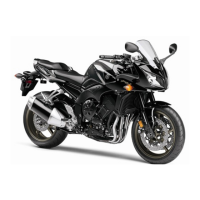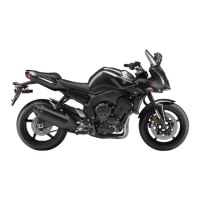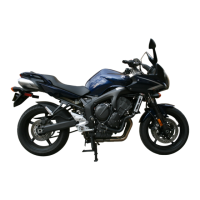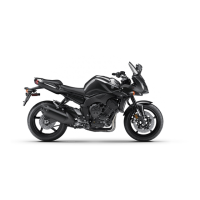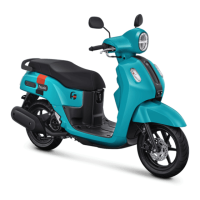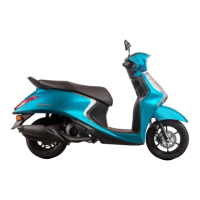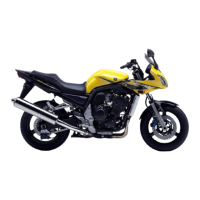Do you have a question about the Yamaha Fazer and is the answer not in the manual?
Yamaha Motor India Pvt. Ltd. contact and service information.
Safety warnings, cautions, and notes for using the manual.
Guidelines for safe motorcycle operation and awareness.
Basic methods for effective motorcycle braking.
Specific cautions to follow during braking.
Identification of parts on the left side of the motorcycle.
Identification of parts on the right side of the motorcycle.
Identification of motorcycle controls and instruments.
Operation of the main switch for ignition and lighting systems.
Description of the speedometer and odometer functions.
Description of the tachometer function and RPM indication.
Explanation of various indicator lights on the instrument panel.
Operation of the turn signal switch for indicating turns.
Explanation of various handlebar switches like lights, dimmer, horn.
How to use starter and kill switches for engine operation.
Operation of the clutch lever for disengaging/engaging the clutch.
How to use the shift pedal for changing gears.
Operation of the front brake lever to apply the front brake.
Operation of the rear brake pedal to apply the rear brake.
Instructions for opening and closing the fuel tank cap.
Information on fuel level, capacity, and recommended fuel type.
Operation and positions of the fuel cock.
How to use the starter lever for cold engine starting.
How to use the kick starter to start the engine.
Instructions for removing and installing the seat.
Location and use of the storage compartment.
How to adjust the rear shock absorber preload.
Function of the stay lock for mounting a helmet lock.
Checklist of items to inspect before operating the motorcycle.
Checks for control cables, meter cables, and pivots.
Checking chassis fasteners and lock operations.
Checks for fuel tank, lights, signals, switches, and battery.
Step-by-step guide to starting and warming up a cold engine.
Procedure for starting a warm engine.
How to use the transmission and shift pedal for gear changes.
Advice on how to improve fuel efficiency while riding.
Guidelines for the initial 1,000 km of operation to break in the engine.
Instructions for safely parking the motorcycle.
Information about the tool kit provided and other necessary tools.
Schedule for regular maintenance tasks and intervals.
Procedures for removing and installing motorcycle panels.
Instructions for removing and installing panel B.
Instructions for installing panel A.
Instructions for installing panel B.
How to inspect, gap, and install the spark plug.
Procedure for checking and replacing engine oil.
How to clean and maintain the air filter.
Information on carburetor adjustment, recommending dealer service.
Procedure for adjusting the engine idle speed.
How to adjust the free play of the throttle cable.
Importance of valve clearance adjustment, recommending dealer service.
Recommendations for tyre air pressure and checking.
How to inspect tyres for wear, damage, and tread depth.
Inspection and maintenance of wheels and spokes.
How to adjust the free play of the clutch lever.
Adjusting rear brake pedal free play and brake light switch.
Checking front brake pad and rear brake shoe wear.
How to check and maintain the brake fluid level.
Recommendations for changing brake fluid and related components.
How to check the slack of the drive chain.
Procedure for adjusting the drive chain slack.
How to lubricate the drive chain.
Inspection and lubrication of control cables.
Lubrication of the throttle cable and grip assembly.
Lubrication of brake and shift pedal pivoting parts.
Lubrication of center and sidestand joints.
How to inspect the front forks for damage and smooth operation.
How to inspect the steering for wear and looseness.
When to have wheel bearings inspected.
Checking battery electrolyte level and terminal tightness.
Procedures for storing the battery during long periods of non-use.
How to replace a blown fuse and precautions.
Steps for replacing the headlight bulb.
How to replace turn signal and taillight bulbs.
Procedure for removing the front wheel.
Steps for installing the front wheel.
Procedure for removing the rear wheel.
Steps for installing the rear wheel.
General advice on troubleshooting and seeking dealer help.
A chart to diagnose starting issues with the engine.
Guidelines for cleaning the motorcycle.
Procedures for storing the motorcycle for long periods.
Basic model information and physical dimensions of the motorcycle.
Engine type, oil type, capacity, and filter details.
Specifications for air filter, fuel tank, and carburetor.
Specifications for spark plug, clutch, and transmission.
Tyre sizes and air pressure specifications.
Specifications for wheels, brakes, and suspension systems.
Specifications for electrical system, battery, and bulbs.
Location of key, frame, and engine serial numbers.
Inspection points for the motorcycle frame.
Checks for rear brake free play.
Checks for clutch lever and throttle grip free play.
Checks for steering movement and front fork/rear shock absorber.
Inspection of tyre pressure, rim, spokes, and locks.
Engine oil level check and fastener torque specifications.
Checks for spark plug, valve clearance, and carburetor.
Checks for drive chain, brake fluid, and fasteners.
Checks for ignition, switches, bulbs, and battery.
Checks to be performed during a road test.
Explanation of lock operations and lever controls.
Correct tyre pressures and brake usage advice.
Advice on acceleration, braking, clutch use, and parking.
Adjusting front and rear shock absorbers to the same position.
Location of storage, panel use, and battery maintenance.
Chain slack, spark plug, and engine oil maintenance.
Service schedule, emission norms, and warranty terms.
Simple steps to keep the environment clean.
List of recommended actions for the motorcycle owner.
List of actions to avoid for the motorcycle owner.
Steps for measuring CO emission levels.
Components that affect the motorcycle's emission levels.
Yamaha Motor India Pvt. Ltd. contact and service information.
Safety warnings, cautions, and notes for using the manual.
Guidelines for safe motorcycle operation and awareness.
Basic methods for effective motorcycle braking.
Specific cautions to follow during braking.
Identification of parts on the left side of the motorcycle.
Identification of parts on the right side of the motorcycle.
Identification of motorcycle controls and instruments.
Operation of the main switch for ignition and lighting systems.
Description of the speedometer and odometer functions.
Description of the tachometer function and RPM indication.
Explanation of various indicator lights on the instrument panel.
Operation of the turn signal switch for indicating turns.
Explanation of various handlebar switches like lights, dimmer, horn.
How to use starter and kill switches for engine operation.
Operation of the clutch lever for disengaging/engaging the clutch.
How to use the shift pedal for changing gears.
Operation of the front brake lever to apply the front brake.
Operation of the rear brake pedal to apply the rear brake.
Instructions for opening and closing the fuel tank cap.
Information on fuel level, capacity, and recommended fuel type.
Operation and positions of the fuel cock.
How to use the starter lever for cold engine starting.
How to use the kick starter to start the engine.
Instructions for removing and installing the seat.
Location and use of the storage compartment.
How to adjust the rear shock absorber preload.
Function of the stay lock for mounting a helmet lock.
Checklist of items to inspect before operating the motorcycle.
Checks for control cables, meter cables, and pivots.
Checking chassis fasteners and lock operations.
Checks for fuel tank, lights, signals, switches, and battery.
Step-by-step guide to starting and warming up a cold engine.
Procedure for starting a warm engine.
How to use the transmission and shift pedal for gear changes.
Advice on how to improve fuel efficiency while riding.
Guidelines for the initial 1,000 km of operation to break in the engine.
Instructions for safely parking the motorcycle.
Information about the tool kit provided and other necessary tools.
Schedule for regular maintenance tasks and intervals.
Procedures for removing and installing motorcycle panels.
Instructions for removing and installing panel B.
Instructions for installing panel A.
Instructions for installing panel B.
How to inspect, gap, and install the spark plug.
Procedure for checking and replacing engine oil.
How to clean and maintain the air filter.
Information on carburetor adjustment, recommending dealer service.
Procedure for adjusting the engine idle speed.
How to adjust the free play of the throttle cable.
Importance of valve clearance adjustment, recommending dealer service.
Recommendations for tyre air pressure and checking.
How to inspect tyres for wear, damage, and tread depth.
Inspection and maintenance of wheels and spokes.
How to adjust the free play of the clutch lever.
Adjusting rear brake pedal free play and brake light switch.
Checking front brake pad and rear brake shoe wear.
How to check and maintain the brake fluid level.
Recommendations for changing brake fluid and related components.
How to check the slack of the drive chain.
Procedure for adjusting the drive chain slack.
How to lubricate the drive chain.
Inspection and lubrication of control cables.
Lubrication of the throttle cable and grip assembly.
Lubrication of brake and shift pedal pivoting parts.
Lubrication of center and sidestand joints.
How to inspect the front forks for damage and smooth operation.
How to inspect the steering for wear and looseness.
When to have wheel bearings inspected.
Checking battery electrolyte level and terminal tightness.
Procedures for storing the battery during long periods of non-use.
How to replace a blown fuse and precautions.
Steps for replacing the headlight bulb.
How to replace turn signal and taillight bulbs.
Procedure for removing the front wheel.
Steps for installing the front wheel.
Procedure for removing the rear wheel.
Steps for installing the rear wheel.
General advice on troubleshooting and seeking dealer help.
A chart to diagnose starting issues with the engine.
Guidelines for cleaning the motorcycle.
Procedures for storing the motorcycle for long periods.
Basic model information and physical dimensions of the motorcycle.
Engine type, oil type, capacity, and filter details.
Specifications for air filter, fuel tank, and carburetor.
Specifications for spark plug, clutch, and transmission.
Tyre sizes and air pressure specifications.
Specifications for wheels, brakes, and suspension systems.
Specifications for electrical system, battery, and bulbs.
Location of key, frame, and engine serial numbers.
Inspection points for the motorcycle frame.
Checks for rear brake free play.
Checks for clutch lever and throttle grip free play.
Checks for steering movement and front fork/rear shock absorber.
Inspection of tyre pressure, rim, spokes, and locks.
Engine oil level check and fastener torque specifications.
Checks for spark plug, valve clearance, and carburetor.
Checks for drive chain, brake fluid, and fasteners.
Checks for ignition, switches, bulbs, and battery.
Checks to be performed during a road test.
Explanation of lock operations and lever controls.
Correct tyre pressures and brake usage advice.
Advice on acceleration, braking, clutch use, and parking.
Adjusting front and rear shock absorbers to the same position.
Location of storage, panel use, and battery maintenance.
Chain slack, spark plug, and engine oil maintenance.
Service schedule, emission norms, and warranty terms.
Simple steps to keep the environment clean.
List of recommended actions for the motorcycle owner.
List of actions to avoid for the motorcycle owner.
Steps for measuring CO emission levels.
Components that affect the motorcycle's emission levels.
| Brand | Yamaha |
|---|---|
| Model | Fazer |
| Category | Motorcycle |
| Language | English |
